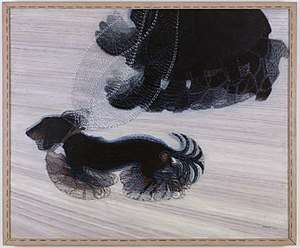Neo-primitivism
Neo-primitivism was a Russian art movement which took its name from the 31-page pamphlet Neo-primitivizm, by Aleksandr Shevchenko (1913). In the pamphlet Shevchenko proposes a new style of modern painting which fuses elements of Cézanne, Cubism and Futurism with traditional Russian 'folk art' conventions and motifs, notably the russian icon and the lubok.
Neo-primitive artists
Russian artists associated with Neo-primitivism include:
- David Burlyuk
- Marc Chagall
- Pavel Filonov
- Natalia Goncharova
- Mikhail Larionov
- Kasimir Malevich
- Aleksandr Shevchenko
- Igor Stravinsky
gollark: WHY, with the JIT compiler, for maximum performance.
gollark: Here is the decoder program.
gollark: I encoded 4MB of data from a project as an image, ran it through imageencode.py, then converted it to webp.
gollark: It's only this size because I had to losslessly compress it.
gollark: My mother is not an *image*, thank you.
References
- Shevchenko, Aleksandr. 1913. Neo-primitivizm: ego teoriia, ego vozmozhnosti, ego dostizheniia. Moscow: [s.n.].
Further reading
- Cowell, Henry. 1933. "Towards Neo-Primitivism". Modern Music 10, no. 3 (March–April): 149–53. Reprinted in Essential Cowell: Selected writings on Music by Henry Cowell, 1921–1964, edited by Richard Carter (Dick) Higgins and Bruce McPherson, with a preface by Kyle Gann, 299–303. Kingston, NY: Documentext, 2002. ISBN 978-0-929701-63-9.
- Doherty, Allison. 1983. "Neo-Primitivism". MFA diss. Syracuse: Syracuse University.
- Floirat, Anetta. 2015a. "Chagall and Stravinsky: Parallels Between a Painter and a Musician Convergence of Interests", Academia.edu (April).
- Floirat, Anetta. 2015b. "Chagall and Stravinsky, Different Arts and Similar Solutions to Twentieth-Century Challenges". Academia.edu (April).
- Floirat, Anetta. 2016. "The Scythian Element of the Russian Primitivism, in Music and Visual arts. Based on the Work of Three Painters (Goncharova, Malevich and Roerich) and Two Composers (Stravinsky and Prokofiev)". Academia.edu.
- Garafola, Lynn. 1989. "The Making of Ballet Modernism". Dance Research Journal 20, no. 2 (Winter: Russian Issue): 23–32.
- Hicken, Adrian. 1995. "The Quest for Authenticity: Folkloric Iconography and Jewish Revivalism in Early Orphic Art of Marc Chagall (c. 1909–1914)". In Fourth International Symposium Folklore–Music–Work of Art, edited by Sonja Marinković and Mirjana Veselinović-Hofman, 47–66. Belgrade: Fakultet Muzičke Umetnosti.
- Nemirovskaâ, Izol'da Abramovna [Немировская, Изольда Абрамовна]. 2011. "Музыка для детей И.Стравинского в контексте художественной культуры рубежа XIX-ХХ веков" [Stravinsky's Music for Children and Art Culture at the Turn of the Twentieth Century]. In Вопросы музыкознания: Теория, история, методика. IV [Problems in Musicology: Theory, History, Methodology. IV], edited by Ûrij Nikolaevic Byckov [Юрий Николаевич Бычков] and Izol'da Abramovna Nemirovskaâ [Изольда Абрамовна Немировская], 37–51. Moscow: Gosudarstvennyj Institut Muzyki im. A.G. Snitke. ISBN 978-5-98079-720-1.
- Sharp, Jane Ashton. 1992. "Primitivism, 'Neoprimitivism', and the Art of Natal'ia Gonchrova, 1907–1914". Ph.D. diss. New Haven: Yale University.
This article is issued from Wikipedia. The text is licensed under Creative Commons - Attribution - Sharealike. Additional terms may apply for the media files.
